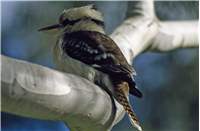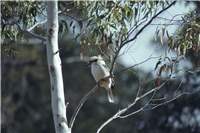Family
Alcedinidae
Genus
Dacelo
Species
novaeguineae
Threats/Control Methods - Regional
Pesticides may be harmful due to the high presence of insects in their diets. During winter, mortality rates may increase due to starvation. Loss of breeding hollows is also an issue for the species, adversely suffering from competition for decreasing habitat with introduced species such as Honeybees (Apis mellifera), Common Mynas (Acridotheres tristis ) and Starlings (Sternus vulgaris).
Threats/Control Methods - Local
The Laughing Kookaburra is prone to injury from collisions with cars or drowning in suburban pools or ponds.
Local/Urban Actions
Deliberately feeding the species is not recommended as sometimes this can lead onto nutritional defects in chicks. The best way to help the species may be to build a horizontal nest box 5-10m above the ground, with a 14cm entrance diameter and a 30cm inside diameter. Ensure the nest box is visible and pest birds such as Common Mynas (Acridotheres tristis ) or Starlings (Sternus vulgaris) are not using it.
Common Names
Kookaburra, Laughing Kookaburra, Great Brown Kingfisher, Laughing Jackass, Bushman's Clock
Distinguishing Features
The laughing kookaburra is distinguished by its laugh. The plumage on the chest is an off-white coloured, just slightly mottled with brown plumage. A brown stripe runs from the beak just under the eye the back of the head, while the wings are mainly brown apart from a stripe of pale blue plumage. The tails has a distinctive horizontal orange-brown and black striping.
Survey Techniques
The distinctive loud call, often heard in the morning, makes the presence of the species easy to detect. Visual sightings are also common. Sometimes birds, of numerous species including the Laughing Kookaburra, may be seen with a metal band around one of their legs, sometimes such bands will have an address for contact should a dead banded bird be found. Scientists use the metal bands to monitor the movement and lifespan of banded birds.
Species Call
Melodic laughter of 'koo-koo-ka-ka-kook'.
Similar Species
The thick beak and body shape is similar to that of the Sacred Kingfisher (Todiramphus sanctus).
Distribution
Extends over most of the eastern half of Australia, including QLD, NSW, ACT, VIC and TAS, as well as the southwestern corner of WA.
Country of Origin
Australia
Conservation (Pet/Pest) Status - Regional
Found throughout the ACT, although most populations occur within Namadgi National Park. Often found within suburbs bordering Nature Parks.
Conservation (Pet/Pest) Status - National
Secure, not listed under the EPBC Act 1999.
LSCCES Population
Kookaburras do not like built up areas and most birds were sighted at the ANBG or on BMt and the CSIRO's vegetated areas.
Associated vegetation community
The Kookaburra survives in many habitats, however in the Canberra region it prefers open forest and woodland areas.
Limiting Resources
Kookaburras require tree hollows for breeding.
Breeding
Within the ACT, the species has been observed inspecting tree-hollows starting at mid-July. Dependent young have been observed from the end of November through to the end of April.
Behaviour
Kookaburras are a sedentary species, occupying the same habitat throughout the year. The species is sometimes a co-operative breeder, where mature siblings sometimes aiding in the rearing of infant siblings. Calls are used to communicate with other groups and reinforce boundaries.
Functional Group
The species is mainly an Insectivore, although small vertebrates are also found in the diet.
Food Species
Lizards, Snakes, Insects, Earthworms and rodents all make up a substantial part of their diet.
Predators
Owls, Diurnal raptors, Goannas, Quolls, Pythons, Cats (Felis catus) and Foxes (Vulpes vulpes).
Interesting Fact
The Kookaburra species are the largest member of the kingfisher family and usually live for 20 years or more.
References - (reader suitability of references, P=Primary teachers, S=Secondary students, T=Tertiary students and researchers)
Books:Canberra Ornithologists Group. 2000. Birds of Canberra Gardens. Canberra Ornithologists Group & ACT Department of urban Services. Canberra, Australia. P, S, T
Canberra Ornithologists Group & McComas Taylor. 1992. Birds of the Australian Capital Territory. An Atlas. Canberra Ornithologists Group & National Capital Planning Authority. Canberra, Australia. S, T
Delgale, J. 1997. Attracting Birds to your Garden in Australia. New Holland Publishing. NSW. P, S, T
Legge, S. 2004. Kookaburra: King of the Bush. CSIRO Publishing. Victoria, Australia. S, T
Schodde, R. and Tideman, S. (eds) 1990. Reader's Digest Complete Book of Australian Birds (2nd Edition). Reader's Digest Services Pty Ltd. Sydney. P, S, T
Journals:Lowe, K. 1991. Preliminary Experiments on the Reporting of the Recovery of Banded Birds in South-Eastern Australia. Wildl.Res.18:413-419. T
Legge, S. 2000. Siblicide in the cooperatively breeding laughing kookaburra(Dacelo novaeguineae). Behav Ecol Sociobiol .48:293-302 T
Online Publications:Australian National Botanic Gradens.2005. Common Birds of the Australian National Botanic Gardens. [online]. Available at: http://www.anbg.gov.au/birds/birds.html P, S
Department of Environment and Conservation. 2005. Plants & Animals: Laughing Kookaburra. [online]. Available at:http://www.calm.wa.gov.au/plants_animals/odd_kookaburra.html P, S, T
Department of Environment and Conservation, NSW. 2004. Laughing Kookaburra. [online]. Available at:http://www.nationalparks.nsw.gov.au/npws.nsf/Content/The%20laughing%20kookaburra P, S, T





 Top
Top Top
Top